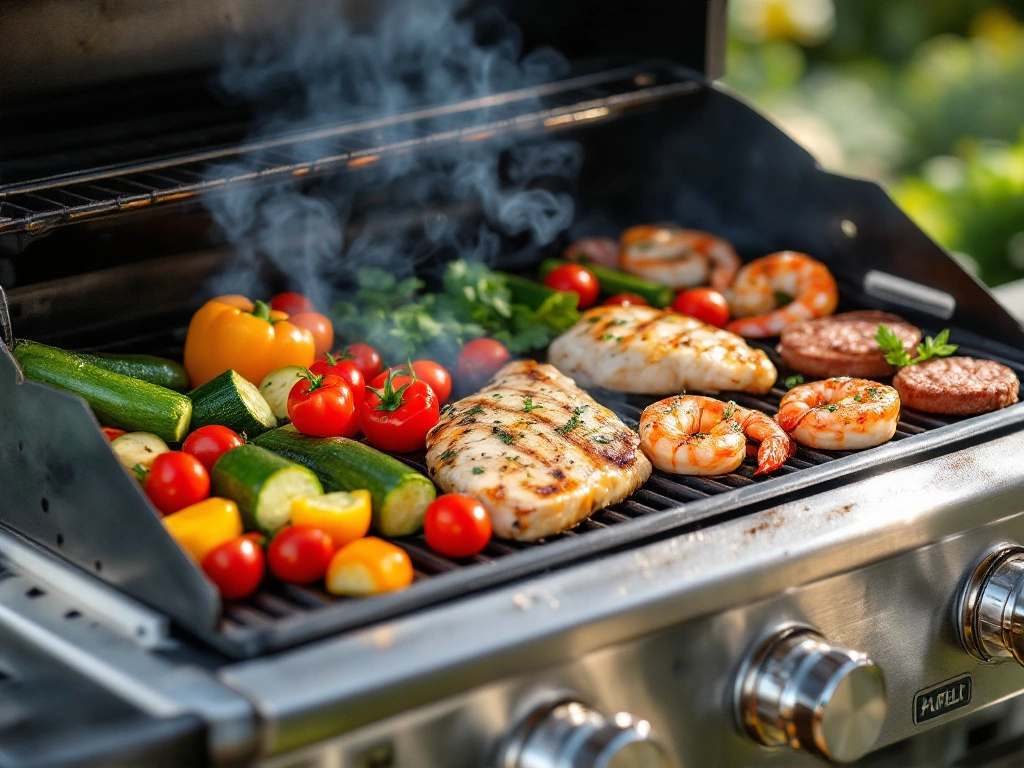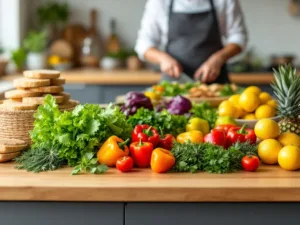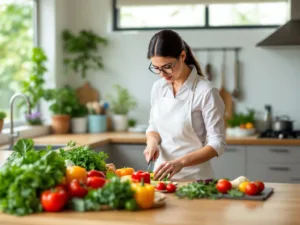How to Prepare Healthy Food Using Only Natural Ingredients: A Comprehensive Guide to Wholesome Eating
Introduction
In a world increasingly dominated by processed foods, artificial additives, and quick-fix meals, the importance of returning to natural ingredients cannot be overstated. The food we consume directly impacts our health, energy levels, and overall well-being. Preparing healthy food using only natural ingredients is not just a trend; it’s a lifestyle choice that can lead to long-term benefits. This article aims to provide a comprehensive guide on how to prepare healthy, delicious meals using only natural ingredients. From understanding what constitutes natural ingredients to practical tips and recipes, this guide will equip you with the knowledge and skills to transform your kitchen into a haven of wholesome eating.
What Are Natural Ingredients?
Defining Natural Ingredients
Natural ingredients are those that are derived from nature and have undergone minimal processing. They are free from artificial additives, preservatives, and synthetic chemicals. Examples include fresh fruits and vegetables, whole grains, nuts, seeds, legumes, and unprocessed meats and dairy products.
Benefits of Natural Ingredients
- Nutritional Value: Natural ingredients are rich in essential nutrients, including vitamins, minerals, antioxidants, and fiber, which are crucial for maintaining good health.
- No Harmful Additives: By avoiding artificial additives and preservatives, you reduce the risk of adverse health effects associated with these substances.
- Better Taste: Natural ingredients often have a superior taste and texture compared to their processed counterparts.
- Environmental Impact: Choosing natural, sustainably sourced ingredients can have a positive impact on the environment.
Planning Your Natural Ingredient Kitchen
Stocking Your Pantry
- Whole Grains: Brown rice, quinoa, oats, whole wheat flour, and barley.
- Legumes: Lentils, chickpeas, black beans, and kidney beans.
- Nuts and Seeds: Almonds, walnuts, chia seeds, flaxseeds, and sunflower seeds.
- Healthy Fats: Olive oil, coconut oil, avocado oil, and ghee.
- Sweeteners: Honey, maple syrup, and dates.
- Herbs and Spices: Basil, oregano, turmeric, cumin, and cinnamon.
- Condiments: Apple cider vinegar, tamari, and mustard.
Fresh Produce
- Vegetables: Leafy greens, carrots, bell peppers, broccoli, and zucchini.
- Fruits: Apples, bananas, berries, citrus fruits, and avocados.
- Proteins: Grass-fed beef, free-range poultry, wild-caught fish, and organic eggs.
- Dairy: Organic milk, yogurt, and cheese.
Essential Cooking Techniques for Natural Ingredients
Steaming
Steaming is a gentle cooking method that preserves the nutrients and natural flavors of vegetables. Use a steamer basket or a simple pot with a lid to steam broccoli, carrots, and green beans.
Roasting
Roasting enhances the natural sweetness of vegetables and brings out rich flavors in meats. Toss vegetables like sweet potatoes, Brussels sprouts, and cauliflower with olive oil, salt, and pepper, then roast at 400°F (200°C) until tender.
Grilling
Grilling adds a smoky flavor to meats and vegetables. Marinate chicken or fish with natural ingredients like lemon juice, garlic, and herbs before grilling. Grill vegetables like zucchini, eggplant, and bell peppers for a delicious side dish.
Blanching
Blanching involves briefly boiling vegetables and then plunging them into ice water to stop the cooking process. This technique is ideal for preserving the color and texture of green beans, asparagus, and peas.
Fermenting
Fermentation is a natural process that enhances the nutritional value of foods. Try making your own sauerkraut, kimchi, or yogurt using natural ingredients.
Practical Tips for Cooking with Natural Ingredients
Meal Planning
- Plan Ahead: Create a weekly meal plan to ensure you have all the necessary ingredients on hand.
- Batch Cooking: Prepare large quantities of staple foods like grains and legumes to use throughout the week.
- Seasonal Eating: Choose fruits and vegetables that are in season for the best flavor and nutritional value.
Reading Labels
- Ingredient List: Look for products with short ingredient lists and recognizable items.
- Avoid Additives: Steer clear of products with artificial colors, flavors, and preservatives.
- Organic Options: Whenever possible, choose organic products to avoid pesticides and GMOs.
Cooking from Scratch
- Homemade Sauces: Make your own sauces and dressings using natural ingredients like olive oil, vinegar, and herbs.
- Baking: Bake your own bread, muffins, and cookies using whole grain flours and natural sweeteners.
- Snacks: Prepare healthy snacks like trail mix, energy bars, and vegetable chips at home.
Recipes Using Natural Ingredients
Breakfast: Quinoa Porridge with Fresh Berries
Ingredients:
- 1 cup quinoa
- 2 cups almond milk
- 1 tablespoon honey
- 1 teaspoon cinnamon
- Fresh berries (strawberries, blueberries, raspberries)
Instructions:
- Rinse the quinoa under cold water.
- In a medium saucepan, combine quinoa and almond milk. Bring to a boil, then reduce heat and simmer for 15 minutes, stirring occasionally.
- Stir in honey and cinnamon.
- Serve warm, topped with fresh berries.
Lunch: Grilled Chicken Salad with Avocado Dressing
Ingredients:
- 2 chicken breasts
- 1 tablespoon olive oil
- Salt and pepper
- Mixed greens (spinach, arugula, kale)
- Cherry tomatoes
- Cucumber
- Avocado
- Lemon juice
- Garlic
Instructions:
- Preheat grill to medium-high heat. Brush chicken breasts with olive oil and season with salt and pepper.
- Grill chicken for 6-7 minutes per side, or until cooked through. Let rest, then slice.
- In a blender, combine avocado, lemon juice, garlic, and a splash of water. Blend until smooth.
- Toss mixed greens, cherry tomatoes, and cucumber in a large bowl. Top with sliced chicken and drizzle with avocado dressing.
Dinner: Baked Salmon with Roasted Vegetables
Ingredients:
- 2 salmon fillets
- 1 tablespoon olive oil
- Salt and pepper
- 1 lemon, sliced
- 2 cups mixed vegetables (carrots, broccoli, bell peppers)
- 1 tablespoon fresh dill
Instructions:
- Preheat oven to 375°F (190°C).
- Place salmon fillets on a baking sheet lined with parchment paper. Drizzle with olive oil and season with salt and pepper. Top with lemon slices.
- In a separate bowl, toss mixed vegetables with olive oil, salt, and pepper. Spread evenly on the baking sheet around the salmon.
- Bake for 20-25 minutes, or until salmon is cooked through and vegetables are tender.
- Garnish with fresh dill before serving.
Snack: Homemade Trail Mix
Ingredients:
- 1 cup almonds
- 1 cup walnuts
- 1/2 cup pumpkin seeds
- 1/2 cup dried cranberries
- 1/2 cup dark chocolate chips
Instructions:
- Combine all ingredients in a large bowl.
- Store in an airtight container for up to two weeks.
Conclusion
Preparing healthy food using only natural ingredients is a rewarding endeavor that can significantly improve your health and well-being. By understanding what constitutes natural ingredients, stocking your pantry with wholesome foods, and mastering essential cooking techniques, you can create delicious, nutritious meals that nourish your body and soul. Remember to plan ahead, read labels carefully, and cook from scratch whenever possible. With the recipes and tips provided in this guide, you’re well on your way to embracing a lifestyle of wholesome eating. So, take the first step today, and transform your kitchen into a sanctuary of natural, healthy food. Your body will thank you!









Add comment